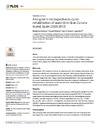Please use this identifier to cite or link to this item:
https://accedacris.ulpgc.es/jspui/handle/10553/36035
| Title: | A long-term retrospective study on rehabilitation of seabirds in Gran Canaria Island, Spain (2003-2013) | Authors: | Montesdeoca, Natalia Calabuig Miranda,Pascual Corbera Sánchez, Juan Alberto Orós Montón, Jorge Ignacio |
UNESCO Clasification: | 3105 Peces y fauna silvestre 310907 Patología |
Keywords: | Penguins Spheniscus-Demersus Light-Induced Mortality Oil-Spill Artificial Lights Corys Shearwater, et al |
Issue Date: | 2017 | Journal: | PLoS ONE | Abstract: | Aims. The aims of this study were to analyze the causes of morbidity and mortality in a large population of seabirds admitted to the Tafira Wildlife Rehabilitation Center (TWRC) in Gran Canaria Island, Spain, from 2003 to 2013, and to analyze the outcomes of the rehabilitation process. Methods We included 1,956 seabirds (133 dead on admission and 1,823 admitted alive) in this study. Causes of morbidity were classified into nine categories: light pollution (fallout), fishing gear interaction, crude oil, poisoning/intoxication, other traumas, metabolic/nutritional disorder, orphaned young birds, other causes, and unknown/undetermined. The crude and stratified (by causes of admission) rates of the three final disposition categories (euthanasia Er, unassisted mortality Mr, and release Rr), the time until death, and the length of stay were also studied for the seabirds admitted alive. Results Yellow-legged Gull (Larus michahellis) was the species most frequently admitted (46.52%), followed by Cory’s Shearwater (Calonectris diomedea borealis) (20.09%). The most frequent causes of morbidity were light pollution (fallout) (25.81%), poisoning/intoxication (24.69%), and other traumas (18.14%). The final disposition rates were: Er = 15.35%, Mr = 16.29%, and Rr = 68.34%. The highest Er was observed in the ‘other traumas’ category (58.08%). Seabirds admitted due to metabolic/nutritional disorder had the highest Mr (50%). The highest Rr was observed in the light pollution (fallout) category (99.20%). Conclusions This survey provides useful information for the conservation of several seabird species. We suggest that at least the stratified analysis by causes of admission of the three final disposition rates, and the parameters time until death and length of stay at the center should be included in the outcome research of the rehabilitation of seabirds. The high release rate for seabirds (68.34%) achieved at the TWRC emphasizes the importance of wildlife rehabilitation centers for the conservation of seabirds. | URI: | https://accedacris.ulpgc.es/handle/10553/36035 | ISSN: | 1932-6203 | DOI: | 10.1371/journal.pone.0177366 | Source: | PLoS ONE [ISSN 1932-6203], v. 12 (5), e0177366 |
| Appears in Collections: | Artículos |
SCOPUSTM
Citations
20
checked on Jun 8, 2025
WEB OF SCIENCETM
Citations
16
checked on Jun 8, 2025
Page view(s)
178
checked on Mar 15, 2025
Download(s)
144
checked on Mar 15, 2025
Google ScholarTM
Check
Altmetric
Share
Export metadata
Items in accedaCRIS are protected by copyright, with all rights reserved, unless otherwise indicated.
